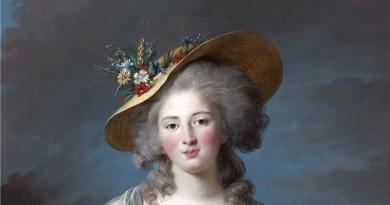Winter is a difficult period for those animals whose forest is their home. The warm season is a real haven for all animals, because there is an abundance of food around. But you definitely need to prepare for winter, because low temperature and nature’s falling asleep during this period does not create too much comfortable conditions for accommodation. Different animals winter in different ways, so in this article we will tell you about the features of the winter life of forest inhabitants.
Animals that hibernate
One way to wait out the cold season is to spend it sleeping. One of the most famous adherents of this method of winter pastime is the bear. The bear's food consists of various berries, roots, nuts, and larvae. By feeding in this way, it accumulates a thick fat layer by winter, which will allow it to go without food for several months. Bears set up their den in a remote and inaccessible place so that no one can disturb their sleep. Such a place is most often a windfall or the root of a large tree. However, the sleep of these large animals is often restless. If the bear is disturbed by something, it may go in search of a quieter shelter. Mother bears in a den give birth to cubs, usually one or two. Even while in deep sleep, the mother bear does not forget about her cubs and continues to feed them. Other animals that hibernate are hedgehogs. All autumn they prepare themselves a warm and reliable winter home, constantly dragging moss and dry leaves into their burrow. Also in the autumn, hedgehogs, like bears, absorb large amounts of food to form fat reserves for the winter. Since the hedgehog is considered a predator, its diet includes mice, frogs, lizards, worms, bird and snake eggs, and various beetles. The “winter sleepers” also include marmots, squirrels, bats, chipmunks, raccoons, badgers and many other animals.Other wintering methods
Almost all animals that live in cold regions are somehow adapted to low temperatures. For example, when it gets cold, some rodents produce a special substance called “brown lard.” It is a source of large amounts of energy. The fur of most animals changes during this period, becoming thicker. In addition, many animals such as squirrels, weasels and stoats change their color, which becomes lighter in winter. Such camouflage helps to survive and hide among the snow cover. Some representatives of the animal world escape from frost and bad weather in the snow. Cold air and wind cannot penetrate the thickness of the snow, so animals dig holes in the snow, thus protecting themselves from snowstorms. Feathered representatives of the animal world also winter in different ways. Most of them, of course, fly away to warmer climes, but there are also those who remain to survive the long and cold winter in the forest. Birds are saved from the cold by subcutaneous fat and fluff. Many make nests and wait there. Crows, for example, nest in large flocks on tree branches. But crossbills are so not afraid of cold weather that they even have chicks in winter period.Wintering of animals ways of surviving the unfavorable winter period by animals of temperate and cold zones. Invertebrate animals have adaptations for surviving unfavorable winter conditions (lower temperatures, shorter lengths) daylight hours, the disappearance of many foods) serve as development cycles; for example, insects survive the winter in one of the cold-resistant, winter-adapted life cycle phases: eggs (locusts, many beetles, butterflies), larvae (some beetles, cicadas, dragonflies, mosquitoes) or pupae (many butterflies). Hibernation is an adaptation to wintering ,
characteristic of some poikilothermic animals (See Poikilothermic animals) (invertebrates, fish, amphibians, reptiles), as well as a number of homeothermic animals (See Homeothermic animals) (mammals - gophers, marmots, dormice, hedgehogs, bats, etc.) ; Some mammals experience hibernation in winter. Animals that do not hibernate - birds, most mammals and fish, some insects - move for the winter to other biotopes or to areas with more favorable climatic conditions and with sufficient food. These seasonal migrations are most pronounced in some mammals (bats, whales, etc.), a number of fish, and especially in birds, most of which winter in the subtropics and tropics (see Animal migrations, Bird migrations). In temperate and cold latitudes, predominantly herbivorous and mixed-feeding birds winter. In homeothermic animals that winter in temperate and cold latitudes, as a result of autumn molting (See Molting), thick fur or feathers appear, which reduces heat loss during the winter cold. As a result of molting, protective colors also appear (hares, ermine, ptarmigan). Many animals and birds deposit a layer of subcutaneous fat in the fall, which protects against cooling and makes it easier to endure starvation. Essential for surviving the winter period is the ability of many mammals to switch to food available during this period, and in the fall to store food (see Stockpiling food by animals).
A number of terrestrial bird species (hazel grouse, black grouse, wood grouse, white partridge) burrow into the snow, which has good heat-insulating properties, at night and in bad weather during the day, and sit out in it for a significant part of the day; In winters with little snow, cases of mass death of these birds are not uncommon. Snow provides good protection from the cold for small mammals that make passages and build nests in it. Small and medium-sized birds and animals spend the night in groups in winter, which reduces heat loss. Lit.: Formozov A.N., Snow cover as an environmental factor, its significance in the life of mammals and birds of the USSR, M., 1946; SchmidtP. Yu., Migrations of fish, 2nd ed., M. - L., 1947; Kalabukhov N.I., Animal Hibernation, 3rd ed., Khar., 1956; Sviridenko P. A., Stocking food with animals, K., 1957; Mikheev A.V., The role of environmental factors in the formation of seasonal migrations of birds of the Eastern Palaearctic, “Uch. zap. Moscow State Pedagogical Institute named after. Lenina", 1964, No. 227; Animal Life, ed. L. A. Zenkevich, vol. 3, M., 1969.
Any living organism needs heat, which ensures the flow of necessary chemical reactions. Therefore, the higher the temperature in the body, the faster, for example, metabolism occurs. But primitive creatures, such as springtails and other small arthropods, lack mechanisms responsible for body temperature and can live on glaciers.
Cold-blooded animals (amphibians and reptiles) use external heat, which not only ensures metabolic processes, but also affects their activity. It is known that in northern latitudes, if amphibians and reptiles are found, they are not in such diversity as in southern latitudes, because otherwise they would be in eternal suspended animation. But in temperate climates, where the external temperature depends on the season, with the onset of cold weather, lizards and frogs fall asleep, hiding under stones or under ice. This hibernation can last up to nine months. Biological scientists also noted that most of these amphibians and reptiles are viviparous. This is explained by the fact that the egg or larva has virtually no chance of becoming an adult in the cold.
Warm-blooded animals (mammals and birds) maintain a constant body temperature, they are always active, and it is easier for them to adapt to winter. In this difficult task, animals are helped by a protective covering: fur, feathers or a layer of subcutaneous fat. The fur of northern mammals has a thick undercoat, the fluffy feathers of birds form an insulating shell of warm air, and who can argue with the reliability of the thirty-centimeter layer of fat under the skin of winter swimmers?
But the cozy cover of most animals and birds does not protect them entirely. So, the nose and paw pads always remain open. To prevent heat loss, the thermoregulation mechanism is triggered: the heat of the internal arterial blood warms the venous blood, which, passing through the extremities subject to cooling, restores the balance of heat in them. Therefore, penguins and seals swimming in icy water, partridges and arctic foxes running in the snow not only do not freeze, but also remove excess heat from the body.
Contrivances
An important condition for survival in winter is the ability of animals to switch to seasonal food or the ability to make food reserves. For example, ungulate mammals, herbivores, in the absence of foliage, learned to dig out twigs and blades of grass that had retained their nutritional value from under a thick layer of snow. At worst, their winter diet may consist of tree bark. Small animals, on the contrary, began to stock up on their usual food. Having rich supplies in their winter homes, they do not have to go out into the cold.
Preparing thrifty animals for winter begins in autumn, when there is an abundance of nuts, seeds, insect larvae, mushrooms and roots around. The richest reserves are made by rodents: squirrels, chipmunks, mice - up to 10 kg. They store their provisions in burrows, covered with branches, leaves and moss; they look into the hiding place only if they are very hungry. It happens that during the winter the reserves remain untouched. The rodents themselves are often found in the reserves of some predators: the steppe polecat, for example, can put up to 50 gophers in its hole.
Arthropods also prepare food for the winter. Termites collect grass, leaves and seeds in their nests, spiders hide captured midges in secluded crevices, gravedigger beetles bury the corpses of small animals and lay eggs in them, providing the larvae with food. Bees also take care of their offspring, leaving honey stored in the hives for their offspring for the winter.
Some birds can also make reserves. In the fall, owls catch mice and small birds and put dozens of them in hollows. Tits and jays hide stored seeds, larvae and caterpillars in bark cracks on tree branches. In most cases, winter supplies serve only as feeding for birds, and they mainly feed on crop remains found in the forest or fly from place to place in search of hidden insects.
It's no secret that many animals have colors that help them blend in with their environment and go unnoticed. Among biologists it is customary to call it patronizing. Therefore, in the warm season, when there is a lot of greenery around, hares, partridges, and arctic foxes are painted unsightly: in gray or brown tones. But in winter, on white snow, such a color would give away a sneaking predator and its hiding prey. To prevent this from happening, the animals have adapted to change color. During molting, the fur not only thickens to better protect the owner from the cold, but also changes color to match the snow.
Healthy sleep
Many animals do not like to store supplies, and they also do not want to look for food under the snow. Their response to winter is hibernation. Moreover, everyone sleeps differently. Rodents - for example, marmots - gather in the burrow of large families and, having fallen asleep, do not show signs of life until spring. Larger mammals such as the bear and badger, contrary to popular belief about their deep sleep, simply doze. Any noise can wake them up. A bear that is awakened cannot always go back to sleep. Then he begins to wander through the forest. A lot of energy is spent on such “staggering”, so the helpless animal becomes aggressive. Because of their cool temperament, these bears are nicknamed “connecting rods.” Badger in winter time usually becomes calmer: even if there is also a raccoon sheltering in his hole, he will only be glad to see the guest - together they will be warmer to wait out the winter. The hedgehog doesn’t disdain someone else’s mink either.
Before the onset of cold weather, animals accumulate the fat necessary for wintering by gorging themselves on high-calorie foods (nuts, roots, berries and insects). Then they prepare a hole or den for themselves, equipping it with moss, cones, branches and foliage. By winter, the body begins to work in an economical mode: the heartbeat and breathing slow down, the body temperature drops by several degrees. By hibernating, the animal seems to seal the body, forcing it to process already accumulated nutrients. Therefore, sleeping animals do not need to wake up to eat.
Many inhabitants of reservoirs also fall asleep throughout the winter.
Under a layer of ice, the water temperature usually does not drop below 0 ºС, and all fish and amphibians, having cooled along with the water, become numb until it warms up from the spring sun. But in reservoirs there are also those who, even in the cold, continue to lead an active lifestyle, for example, burbot. If the reservoir freezes to the very bottom, its inhabitants in whole groups bury themselves in the silt, in a kind of wintering pits. This is how freshwater fish survive the cold: carp, ruffe, perch, catfish. Large fish, such as sturgeon or beluga, in cold water become covered with protective mucus, which sometimes envelops them in whole groups, sleeping together.
Frogs prefer to spend the winter in rivers and fast-flowing streams. In them, the water almost does not freeze, and sleeping amphibians receive a sufficient amount of oxygen through their skin. Related toads and salamanders spend the winter on land, burrowing into the ground or hiding between tree roots. In their snow-covered shelters, the necessary microclimate is created, and, protected from sudden temperature changes, amphibians will not turn into lifeless ice. Otherwise, the liquid in their body can crystallize and literally rupture the fragile shell - the skin of the animal. To protect against such damage, American wood frogs produce glucose when they freeze. The rest have to look for reliable places for wintering.
On the road
Another way to escape the winter cold and hunger is to move to warmer climes. This is what most birds do: in the fall they migrate to areas with more favorable climatic conditions and with sufficient food, and in the spring they return to their nests back to the north. Why don’t birds want to live permanently where it’s always warm and there’s plenty of food? The thing is that in the summer in northern latitudes the length of daylight hours increases, and birds have more opportunities to feed their offspring. Therefore, there are more egg layings in birds nesting in the north compared to their tropical relatives.
Mammals, such as whales, also migrate to more favorable regions. Unlike birds, they prefer to reproduce in the south, in warm waters. During the summer months, some species of whales stay in the Arctic Ocean basin, where they feed. Having accumulated the required amount of fat by autumn, the whales begin to migrate south, reaching shallow lagoons off the western shores of the Gulf of California, where their calves are born. By summer, adult and young whales return to the Arctic. This behavior is no coincidence: newborn whales do not have enough fat to protect them from the cold in the northern seas, so they spend the first weeks of life, while it accumulates, in the warmth.
Animals that remain in their native lands during the winter can move from place to place in search of food. This is what reindeer do when they migrate from the tundra to the forest-tundra and northern taiga, covering a distance of up to 500 km. This is due to the fact that in winter, due to strong winds, the surface of the snow in the tundra is covered with a strong ice crust - an infusion, which greatly complicates access to the favorite food of deer - moss lichen and herbs. In forested areas, the wind is restrained by trees and crust does not form, so nothing prevents the deer from feeding.
Deer constitute the main diet of large predators - wolves. When herds move to winter pastures, wolves move in packs or singly behind them. This preserves the natural food chain, and animals help each other survive in difficult times.
Winter in the northern regions of our planet is a testing time for all living things, the more diverse are the ways animals overcome them. In this sense, a person can only learn perseverance and resourcefulness from his smaller brothers.
^ 9. Interactive task “Evergreens” . Question: “What plants can be called evergreen?” or definition. On the screen: a menu with autumn subseasons and seasons, two rows of windows with 4 windows each: birch, alder, pine, spruce, chickweed, lingonberry, blueberry, strawberry. At the bottom line there are three options for conclusions for the student to choose.
^ 10. Interactive task “Summer-winter green plants”
Question: “What plants can be classified as summer-winter green?” or definition. On the screen: a menu with autumn subseasons and seasons, two rows of windows with 3 windows each: strawberries, blueberries, maynik, lingonberries, gravilat, sorrel. At the bottom line there are three options for conclusions for the student to choose.
The task can be successfully used in lessons on botanical lines, lines of connections in living nature: “Seasonal changes in the life of plants”, “Autumn changes in the life of plants”, “Winter changes in the life of plants”, “ Spring changes in the life of plants", "Plant adaptations", " Environmental groups plants."
^ 11. Interactive task “Autumn changes in the lives of animals.” In the center of the screen is a field for the question: “What animals shed in the fall?” To the right and left of the two central windows there are 3 windows with images: a bear, a hare, a wolf, a squirrel, a vole, and a hedgehog. Under each image window there is a comment box. Below is a field for output (choice from three options).
Seasonal molting is a phenomenon characteristic of all mammals. This process of restructuring in the functioning of the body allows animals to prepare for winter and survive it in the most prosperous manner. So, during molting, the work of the whole organism is reconstructed: rhythms change, the characteristics of the chemical composition of cells and tissues change, fats are stored or preparation for hibernation or winter sleep, the coat also changes. All mammals change their coat from summer to winter during the autumn molt. In spring, reverse molting occurs. All animals shed, including those that go to sleep for the winter (bear, hedgehog and others). The summer coat of mammals consists mainly of spinous hairs, quite coarse hair. In winter wool, a large proportion is made up of downy hair - soft, short and fluffy. The thick undercoat creates an air layer and prevents the body from becoming overcooled. Thus, animals do not overheat in summer and do not freeze in winter. Some animals are also characterized by changes in coat color. First of all, this adaptation was developed in animals that need camouflage (for protection or hunting). Thus, molting with a change in color is characteristic of the hare, squirrel (protection) and ermine (hunting). Mice and voles do not change the color of their fur, since they live under the snow, and their enemies do not see them. The moose, the largest animal in the northern forests, also does not change color.
The task can be used in lessons on the zoological line, the line of connections in living nature: “Seasonal changes in the life of animals”, “Adaptations of animals”.
^ 12. “How animals prepare for winter.” An interactive object that allows the student to match the names of animal actions with the corresponding images of animals (the images of animals are labeled).
In addition to molting, all mammals store fat in preparation for winter (fat is not only a supply of food for hibernating animals), but also a good heat-insulating material. Animals that fall asleep in winter (bear, badger) store a lot of fat, so that it is enough for the whole winter. It is known that if a bear does not accumulate enough fat in the fall, it will not be able to sleep, will not lie down in its den, and will walk through the forest all winter. Such bears are called connecting rods, they are very dangerous, and, unfortunately, by the end of winter they usually die of starvation. Other animals that spend the winter in hibernation (hedgehogs, bats, mice) store a little fat, since in a state of hibernation (anabiosis) they require very little energy (and therefore food). There is also a little fat in animals that are active in winter - hares, wolves, moose and foxes. They need fat as an additional insulating layer and an energy reserve in case of extreme hunger. Some animals that are active in winter store food. This is what squirrels, mice, voles and beavers do. Many animals prepare (build and insulate) shelters for the winter - some, like a bear or badger, to sleep through the whole winter, others - for overnight stays or for severe frost, such as squirrels.
The student should note how different animals prepare for winter. Can be used to consolidate and systematize knowledge on the zoological line, when studying seasonal changes in the life of animals, animal adaptations. It is an interdisciplinary object.
^ 13. In what order do the birds fly south? An interactive research assignment aimed at developing junior schoolchildren ability to establish cause-and-effect relationships.
Migratory or migratory birds are those that are characterized by seasonal movements over fairly long distances. Routes, directions, and wintering (and nesting) sites change slightly. Weather conditions and food supply usually affect the timing of the start and end of migrations, but cannot stop or cancel migrations. In warm weather and in the presence of an abundant food supply, the timing of departure for wintering occurs later. Just like in a late and cold spring, birds arrive later.
Birds from Europe that winter in central and southern Africa are called long-distance migrants, and those that fly to wintering grounds in southern Europe or northern Africa are called short-range migrants. Nearby migrants sometimes remain for the winter in nesting areas. That is why, in mild winters, even in the North-West of Russia you can find wintering rooks, blackbirds, starlings and other short-range migrants. Birds that fly from place to place throughout the year and do not have permanent routes, wintering and nesting places are called nomadic. The movements of these birds are usually determined primarily by the availability of sufficient food. Therefore, during the years when conifer cones are harvested, flocks of crossbills appear (in such years they even nest in the second half of winter), and when there is a rich harvest of rowan berries, waxwings, shuras, and bullfinches appear in forests and cities. And that is why bullfinches cannot be unambiguously classified as migratory birds. In the North-West of Russia, some of these birds fly to wintering grounds in more southern regions, some are nomadic and appear only in years with a large mountain ash harvest, and some bullfinches spend the whole year in our forests - both winter and nest. The latter can be classified as sedentary birds - they spend the entire year in one territory. in winter resident birds often unite in flocks, in spring and summer they form pairs and hatch chicks. These include woodpeckers, pikas, wrens, magpies, jays and other birds.
Migrating birds fly away to wintering grounds and arrive at nesting sites in a strictly defined order.
The first to fly away, even in the middle of summer, are the long-distance migrants – the lentils and the oak berries. At the end of summer, starting from last decade August, and until about the end of September, insectivorous birds fly away (it should be noted that at this time there is still enough food for them!). These include warblers, warblers, swifts, cuckoos, swallows and others. From mid-September until mid-November, herbivorous birds fly away: finches, bramblings, and buntings. At the end of September and October, “omnivorous” birds fly away, feeding on both plant and animal food: thrushes, wagtails. Marsh and semi-aquatic birds (geese, ducks, cranes) fly away with the first frosts, but seagulls are the last to fly away - at the end of November. In spring, the birds return in the reverse order. The timing of spring migration occurs from the end of March to the end of May.
There are images of birds on the screen, and the name of the bird is written under each image. The student must answer the question by placing the arrows on his own. If a student tries to place an arrow incorrectly, the arrow begins to flash red and disappears, and one of the correct arrows appears. The child can change the parameters of one window: nature calendar, daylight hours, air temperature. In response to a change in the parameter, all the others change. After trying several options, you can move on to help or conclusions. Each temperature value is associated with a subseason in accordance with the table. The student can select temperature values from a given range and images of insects. You can sort through temperature values or insect images in any order. When you select an image of an insect, an image of only that insect appears on the screen in accordance with the table and temperature. The thermometer image is saved. A child can go through any number of images of insects, but be sure to look at all temperature options. Otherwise, you can be reminded by flashing the thermometer image with an unselected temperature. After selecting all temperature values, outputs become available in the form of a “one of many” test task.
^ 14. Table constructor “Forest food chains” with reference material. The table designer is a template with windows. The name of the season of the year is displayed in the upper window (summer, autumn, winter, spring). Below there are four windows (two in each row) - they contain images of plants and animals. The lower left window remains unchanged - this is the link of decomposers (bacteria, molds, etc.). Students observe changes, discuss them and draw conclusions.
To develop educational and methodological content of the IUMK in the subject the world around us Some of the most complex modern content lines of the course were selected, namely, “Botanical line”, “Zoological line” and “Line for the study of connections in living nature”. The difficulty in revealing these lines lies in the fact that the teacher often does not have special training in general ecology. When working, he relies on knowledge of botany and zoology. For most working teachers primary school environmental content and working with him seems to be a difficult task. Unfortunately, methodological recommendations for this material are still insufficient and fragmentary.
Lesson notes on these content lines, prepared for methodological filling of ICS using the lesson designer, are focused on the following educational goals: to expand and systematize students’ ideas about the main groups of plants and animals, the connections between them, about the adaptations of animals to obtaining and eating food, about adaptations plants to passive protection from being eaten by animals, about the methods of plant propagation, etc.
Developmental goals include: developing students’ ability to find signs of living beings in plants and animals; development logical thinking children through guessing riddles about plants and animals; through the formation of the ability to classify plants and animals according to given characteristics; improve the ability to classify natural objects according to a given criterion, give a name to a group of objects; improve children’s perception when viewing images of natural objects and analyzing them, etc.
The capabilities of ICS make it possible to prepare primary school teachers to achieve the specified learning goals by developing the ability to select the necessary objects for constructing a video sequence, to construct a video sequence that allows you to build a certain logic for revealing the topic and creates an emotional background for studying, which is important for the age of the students.
^ Examples of test tasks that can be created in the Test Designer
Quest type: “One of many”
They haven't slept all summer, so they sleep in winter.
They are only active when it is warm.
There is no one to hunt them.
Those who feed on carrion;
those that feed on plants;
those that feed on other animals.
Those that feed on insects;
those that feed on fruits, leaves and other parts of plants;
those that feed on dead organisms.
2. Task type: “A few out of many”
Task 1. What helps a fox catch prey? Mark the correct answers.
acute hearing;
keen sense of smell,
sharp teeth;
quiet steps;
fast paws.
small eyes;
big eyes;
soft plumage;
weak claws;
sharp claws;
strong curved beak.
3. Task type: “Word entry”
Task 1: Guess the riddles
1. Only she of all birds
Catches furry caterpillars -
That will be beneficial,
Will save the forest from destruction! (Cuckoo)
2. She hears every rustle
And hunts mice.
There is no vole -
So the little bunny will grab it deftly. (Owl)
3. In the cold it beats until spring
Spruce and pine cones.
Checks the bark too.
The beak is reliable, strong, sharp, -
All the boogers under the bark
He will find it in the summer. (Woodpecker)
4. A hut made of branches,
Underwater entrance
Aspen trunks
They save him in winter. (Beaver)
5. Like bright flowers
Of unusual beauty,
They flutter in the meadow
And the flowers pollinate. (Butterflies)
6. For protection - a sting
Sharpen your dagger.
Striped beauty,
With a thin waist... (Wasp)
7. Who hatches chicks in winter,
Do you find seeds in the cones?
Her beak is not at all simple,
And the name of the bird... (Crossbill)
8. What kind of bird? Crochet beak,
Sees at night as if during the day.
He hears every rustle at night
And hunts mice. (Owl)
9. Pine and spruce seeds
The birds ate in a friendly flock,
And the scales flew into the snow.
What kind of birds have arrived? (Crossbills)
10. Hollowed out a hollow for himself,
It is spacious and warm.
He built a house for his family.
Who is the boss in that house? (Woodpecker)
Task 2. Find out by the bird's description. Enter your answer.
This bird’s head is in a black cap, its back, wings and tail are dark, and its breast is bright yellow, as if it’s dressed up in a yellow vest. In the summer she eats bugs and worms, and in the winter, when there is no food, she eats everything: various grains, bread crumbs, and boiled vegetables. But most of all she is a hunter of fresh, unsalted lard.
These black birds with a red breast appear with the first snow. They feed on the seeds of rowan, maple, and grasses. With the onset of spring, they fly away from us to more northern places.
A bird perched on a frozen tree. How elegant she is in winter! The head and back are black, and on the back of the head there is a bright red spot, and on the black wings there are white spots and stripes.
4. Task type: “Matching”
Task 1. Look at the pictures of birds. Match the features appearance birds and their food.
Images:
Task 2. Living organisms have three main “professions”. Try to determine who performs what “profession” in nature.
5. Task type: “Selection”
Task 1. Highlight the names of insects.
Elk, bee, pike, butterfly, dragonfly, frog, bear, tit, squirrel, bumblebee, grasshopper, som, bug, crow.
Task 2. Highlight the names of the animals.
Elk, owl, pike, boar, bear, butterfly, squirrel, viper, beaver, beetle, perch, crow, hedgehog, mole.
Task 3. Highlight the names of the birds.
Owl, bee, fox, perch, tit, woodpecker, squirrel, duck, frog, gull, mole, sparrow, hare, crucian carp.
Task 4. Highlight the names of the fish.
Bee, pike, dragonfly, bear, perch, viper, frog, roach, som, beaver, crucian carp.
Task 5. Why do animals have tails? Read the text and highlight the words that explain the role of the animal’s tail.
A fox without a tail will be lost. The dogs will chase after her and they will quickly catch her tailless. And their fox with a tail will deceive. She will move her tail to the right, and she will dart to the left. So the red-haired cheat will escape from the chase. And also the fox's tail helps to turn sharply, just like a steering wheel.
When a squirrel jumps from tree to tree, it spreads its fluffy tail, and it, like a parachute, supports her in the air, helps the squirrel keep balance. In the winter cold, squirrel covers up tail like a blanket.
The beaver spends most of its life in water. The tail serves him like a rudder and an oar and, in addition, helps get food. When an animal gnaws a tree, it sits on its hind legs and rests on his wide tail. If a beaver notices danger - a wolf, a large pike - he strikes the water with force with its tail. This slap is like an alarm signal for all the beavers, who immediately dive under the water and hide.
6. Task type: “Lost letter”
Task 1. What helps a hare escape from predators? Insert the correct words.
Fast _______, spicy ________, color ______.
Words for reference: hearing, skins, paws.
7. Task type: “Arrows”
Task 1. Determine whose ears these are. Connect with an arrow the name of the animal and the drawing of its ears.
Task 2. Who moves how? Show with arrows.
Task 3. How do these plants attract pollinating insects? Indicate the correct answers with lines.
8. Task type: “Move to area”
Task 1. Distribute the animals into groups: herbivores, insectivores, carnivores.
Mammals: elk, wild boar, hare, wood mouse, fox, wolf, hedgehog, bear, mole.
In winter, the amount of food decreases significantly, which is why most animals begin to prepare for cold weather in the fall, and some begin to prepare food in the summer. Rodents are the first to collect supplies:
- mice,
- chipmunks,
- grandmas.
Already in the summer, they search throughout the forest for seeds and nuts, depositing them in burrows. This gives them the opportunity to sit in their house all winter and not go outside. During cold weather, rodents sleep almost all the time, interrupting their sleep only to eat.
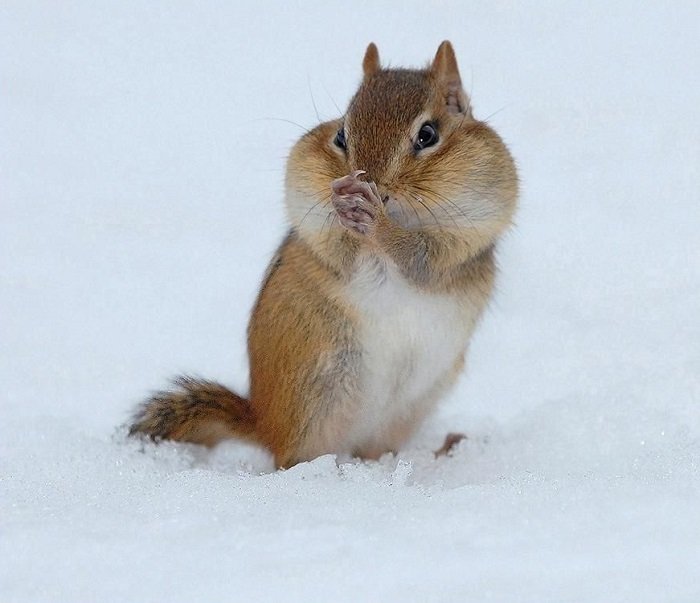
Who isn't afraid of frost?
Foxes, hares and wolves practically do not prepare for frosts, as they spend the winter on their feet in search of food. The bunnies just change their clothes: they change their gray fur coat to a white one so that predators do not notice them on the snow carpet. It is very interesting to watch how animals prepare for winter, because everyone has their own secret.
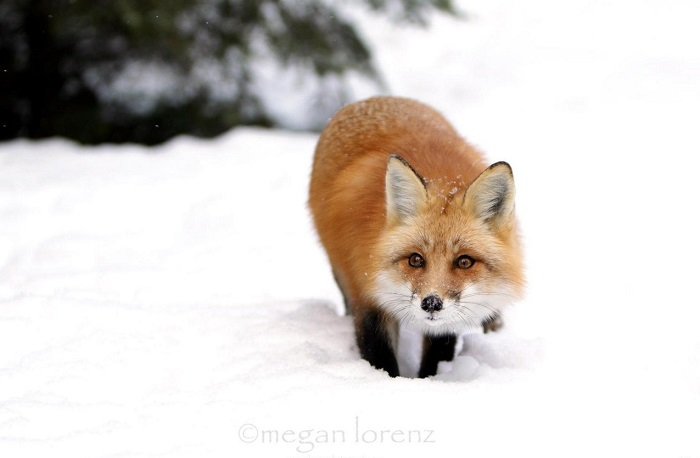
Foxes and wolves
Foxes and wolves do not change the color of their coats, but their fur becomes thicker and fluffier: this makes it easier to survive severe frosts. Wolves gather in packs because it is much more convenient to survive in winter. Sly foxes look for any holes to rest and hide from the snowstorm.
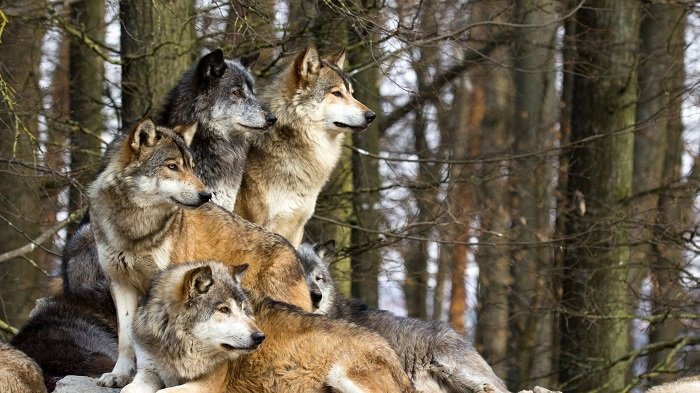
Beavers and squirrels
Squirrels and beavers do not hibernate, but they are trained responsibly. Beavers live in large families, all together they build cozy houses near ponds, next to which they put their food - twigs from trees. They also feed on the roots of plants that grow in water.
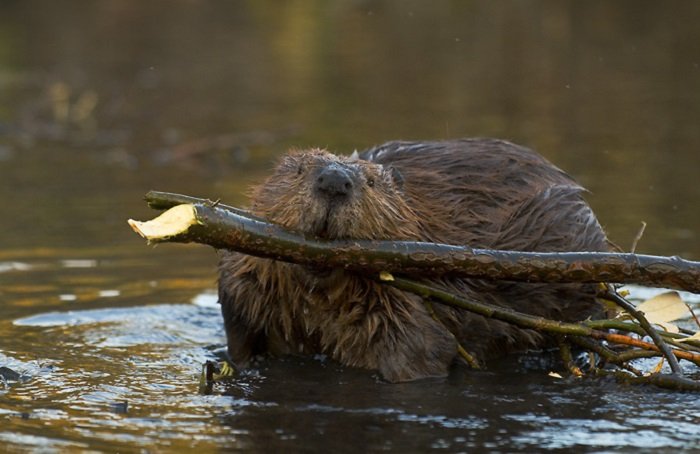
I wonder how a squirrel prepares for winter? Red-haired forest dwellers do not hibernate, although they spend most of their time in their homes - hollows that they build high in the trees.
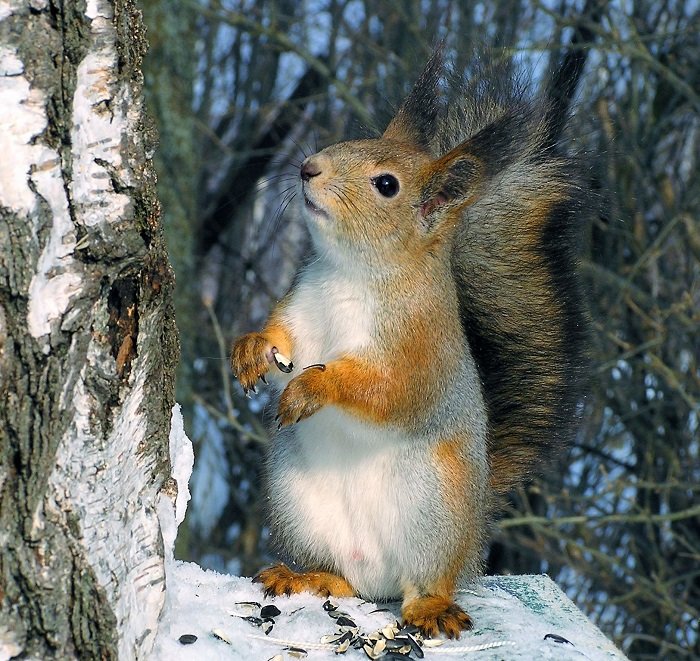
This rodent changes the color of its coat from red to grayish to camouflage itself from predators. What does a squirrel eat in winter? During the cold season, this rodent stocks up with the following belongings:
- acorns,
- mushrooms,
- nuts,
- seeds.
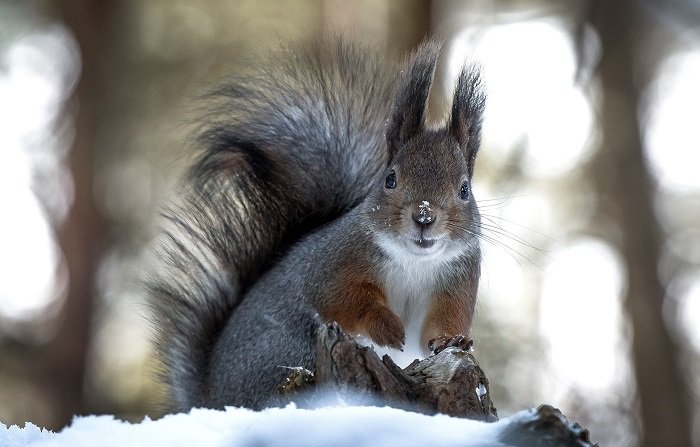
Let's talk about the bear
Bears set up their home in advance. They look for caves, ditches, where they carry leaves, branches, moss, and make a soft mattress on top from spruce branches. When snow falls, it masks the bear's hiding place and keeps it warm.
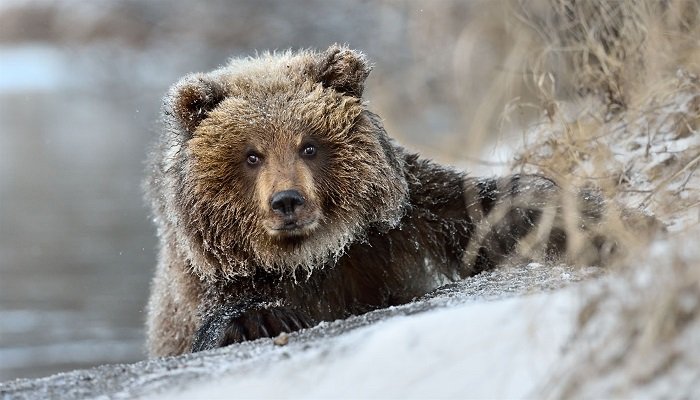
Bears do not store food, but in the fall they actively feed on nuts and fish in order to accumulate as much fat as possible for the winter. In fact, the predator does not sleep, but dozes, and if necessary, it can leave the den. It is in winter that a mother bear gives birth to small cubs.
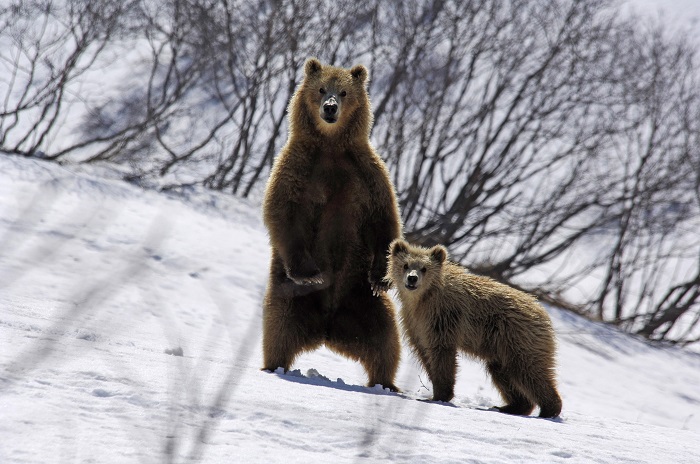
This is how animals spend the winter. Some sleep all winter, others try to stay warm and find food for themselves. But you can learn a lot more interesting things about animals, birds and insects.

